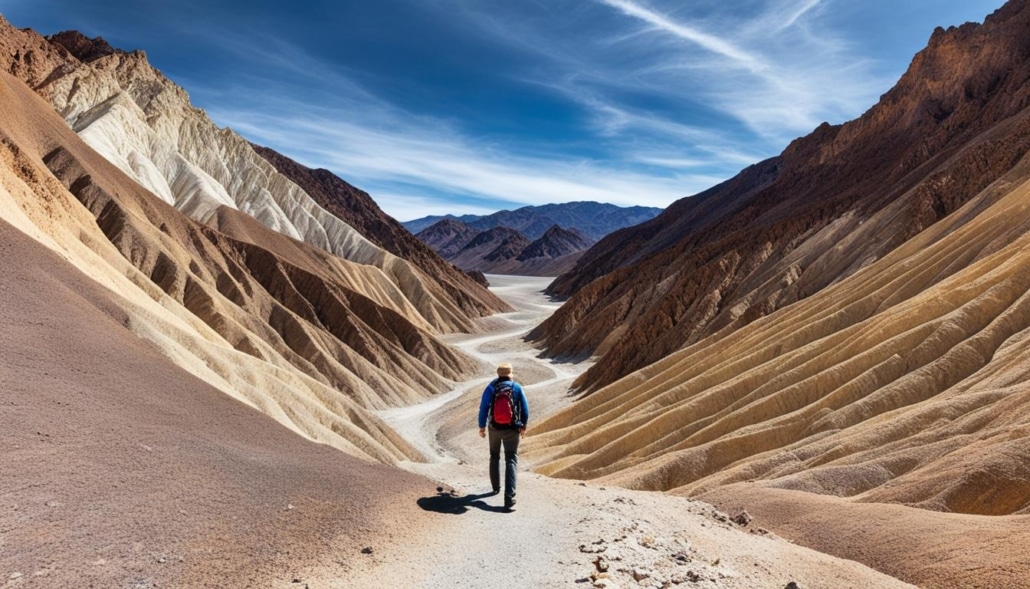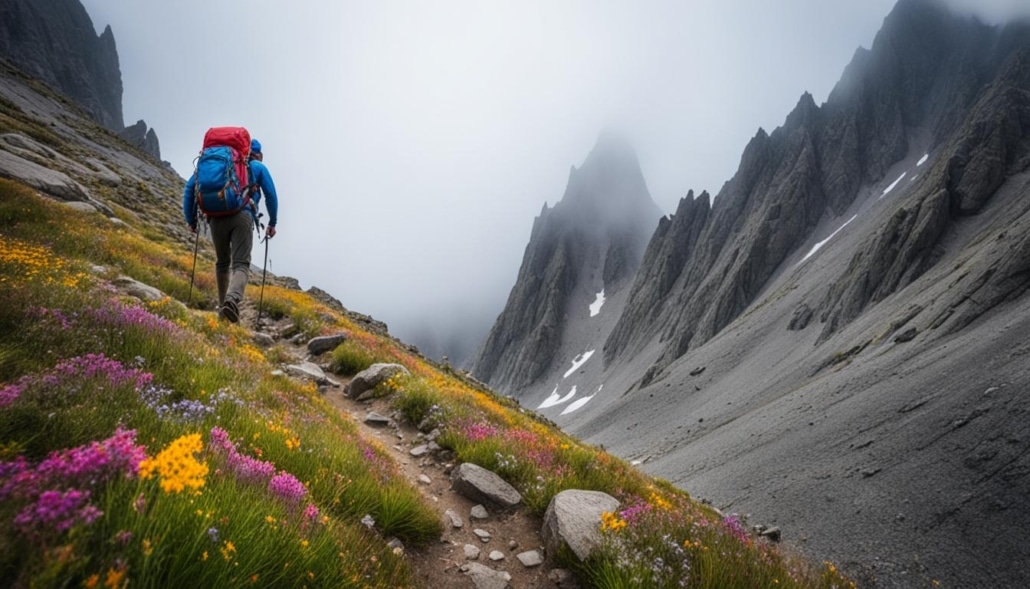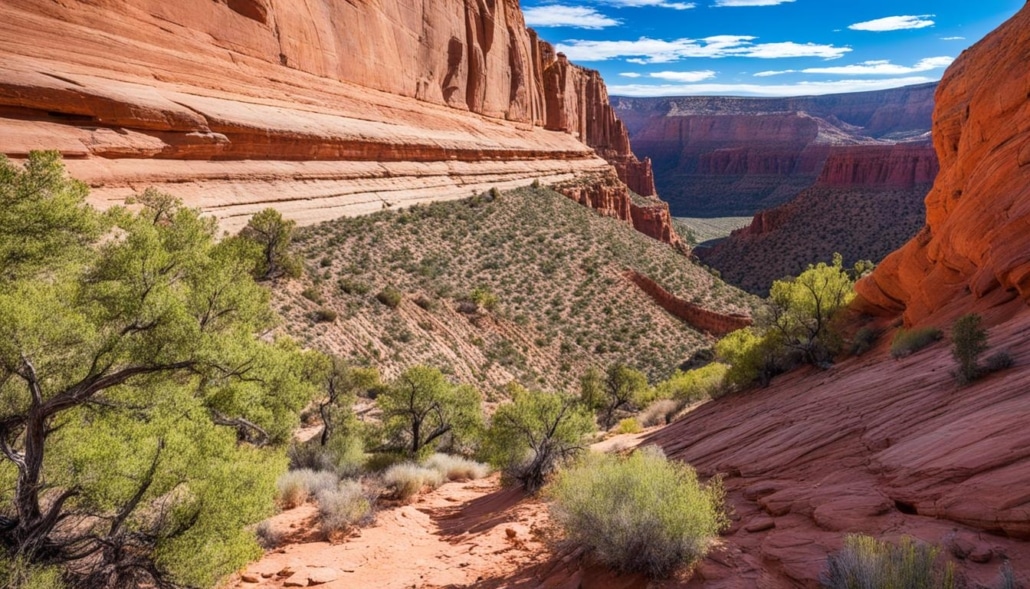Embarking on a journey of adventure travel and hiking awaits those who dare to conquer the legendary Inca Trail. This iconic trek in Peru offers an exhilarating experience, taking hikers through rugged terrains, breathtaking landscapes, and ancient Incan ruins.
The Inca Trail is not for the faint-hearted. Spanning around 26-28 miles, this challenging expedition demands proper preparation, physical fitness, and determination. As hikers navigate steep inclines, descents, and rough paths, they are rewarded with awe-inspiring views and a glimpse into the ancient civilization.
Exploring the Inca Trail is a once-in-a-lifetime opportunity that comes with unique challenges. Trekking at high altitudes above 2,500 meters brings its own obstacles, including thinner air and the risk of altitude sickness. However, with careful planning and the right mindset, adventurers of all ages and abilities can successfully complete this incredible journey.
Key Takeaways:
- Embark on an adventure travel experience by tackling the legendary Inca Trail.
- Prepare physically for the trek by increasing strength and stamina through activities like jogging, cycling, or swimming.
- Achieve proper acclimatization by spending a few days in Cusco before the trail.
- Carry essential gear and pack wisely to ensure comfort and safety throughout the expedition.
- Book the Inca Trail trek in advance and choose a reputable trekking operator for a well-organized and safe experience.
Preparing for the Inca Trail: Fitness and Gear
Before embarking on the Inca Trail, it is crucial to prepare both physically and mentally. The challenging terrain and high altitudes demand a certain level of fitness and the right gear to ensure a safe and enjoyable trek. Here are some essential tips to help you prepare for the Inca Trail:
Fitness for Hiking
To tackle the Inca Trail, it is important to improve your overall strength and stamina. Engaging in regular aerobic exercises such as jogging, running, cycling, or swimming can help build endurance and prepare your body for the demands of the trail. Additionally, incorporating hikes with ascents and declines into your training regimen can simulate the challenging terrain you will encounter on the Inca Trail. Gradually increasing the intensity and duration of your training will help improve your fitness levels and enhance your hiking experience.
| Activities | Benefits |
|---|---|
| Jogging/Running | Improves cardiovascular endurance |
| Cycling | Strengthens leg muscles and improves endurance |
| Swimming | Builds overall body strength and cardiovascular fitness |
Essential Gear for the Inca Trail
Packing the right gear is essential for a successful and comfortable Inca Trail trek. Here are some gear essentials:
- Sturdy and broken-in hiking boots with good ankle support to protect your feet on the rough terrain
- Moisture-wicking and breathable clothing that layers well to adapt to changing weather conditions
- A backpack with a capacity of at least 25-30 liters to carry your personal items and light snacks
- Sunscreen, sunglasses, and a hat to protect yourself from the strong Andean sun
- A lightweight and packable rain jacket or poncho to stay dry during sudden downpours
- A refillable water bottle to stay hydrated throughout the trek
Hiking at high altitudes requires proper gear and preparation. With the right fitness training and essential gear, you’ll be ready to conquer the challenges of the Inca Trail.
By following these preparation tips, you’ll be well-equipped physically and mentally for the Inca Trail adventure, allowing you to fully immerse yourself in the breathtaking beauty of the Peruvian Andes. Embrace the journey while experiencing the wonders of Machu Picchu.
Coping with High Altitude on the Inca Trail
The Inca Trail is a high-altitude trek that poses unique challenges due to the effects of altitude. Altitude sickness is a common concern among hikers, with symptoms such as headaches, nausea, loss of appetite, and fatigue. It is crucial to understand and manage these effects to ensure a safe and enjoyable trek.
Altitude Sickness
Altitude sickness, also known as acute mountain sickness (AMS), is caused by the reduced oxygen levels at high altitudes. It can affect anyone, regardless of age or fitness level, and it is important to recognize the symptoms.
Some common symptoms of altitude sickness include:
- Headaches
- Nausea
- Loss of appetite
- Fatigue
If you experience any of these symptoms, it is essential to take immediate action to prevent the condition from worsening.
Acclimatization
Proper acclimatization is the key to managing altitude on the Inca Trail. Acclimatization allows your body to gradually adjust to the decreased oxygen levels, reducing the risk of altitude sickness. Spending a few days in Cusco before the trek is highly recommended to help your body adapt to the high altitude.
During the acclimatization period, it is important to take it easy and avoid overexertion. Slowly increase your physical activity and give your body time to adjust to the altitude. It is also crucial to stay hydrated by drinking plenty of water and avoiding alcohol and caffeine.
Managing Altitude
In addition to acclimatization, there are several other measures you can take to manage altitude on the Inca Trail:
- Consider using medication for altitude sickness, such as acetazolamide (Diamox), under the guidance of a medical professional.
- Chew coca leaves, a natural remedy commonly used in Peru, as they are believed to alleviate altitude symptoms.
- Take breaks and rest when needed to conserve energy and allow your body to adjust.
- Listen to your body and be aware of any signs of worsening altitude sickness. Seek medical attention if necessary.
Trekking companies often provide oxygen for those experiencing severe altitude symptoms. It is advisable to consult your trekking operator regarding the availability of oxygen and any specific guidelines for managing altitude on the Inca Trail.
It is crucial to prioritize your safety and well-being when it comes to managing altitude on the Inca Trail. By understanding the symptoms of altitude sickness, allowing for proper acclimatization, and taking necessary precautions, you can minimize the risks and fully enjoy the breathtaking experience of hiking the Inca Trail.
Hiking and Camping on the Inca Trail
The Inca Trail is an exhilarating multi-day trek that offers an unforgettable adventure through stunning landscapes and ancient ruins. As you embark on this journey, it’s essential to understand the itinerary, camping arrangements, and the availability of food and water along the trail.
Inca Trail Itinerary
The Inca Trail typically spans four days, covering approximately 6-7 miles per day. Each day presents its own challenges, with steep ascents, descents, and rugged terrain. It’s crucial to pace yourself and enjoy the journey at a comfortable pace to ensure an enjoyable and safe experience.
To give you an idea of the itinerary, here’s a breakdown of the Inca Trail trek:
- Day 1: The trek begins at Kilometer 82 and takes you through beautiful Andean valleys and archaeological sites. You’ll end the day at the first campsite at Wayllabamba.
- Day 2: The second day is the most challenging, with a steep ascent to the highest point of the trail, known as the Dead Woman’s Pass. After reaching the pass, you’ll descend to the second campsite at Pacaymayo.
- Day 3: This day is filled with fascinating archaeological sites, including Runkurakay and Sayacmarca. You’ll spend the night at the third campsite at Wiñay Wayna.
- Day 4: The final day starts early, with a hike to the iconic Sun Gate, where you’ll witness a breathtaking sunrise over Machu Picchu. You’ll then explore the ancient citadel before descending to Aguas Calientes for a well-deserved rest.
Camping on the Inca Trail
Camping is an integral part of the Inca Trail experience. During the trek, you’ll have dedicated campsites with basic facilities such as tents, sleeping mats, and dining areas. The camping gear and equipment are carried by experienced porters, allowing you to hike with a lighter day pack.
Here’s what you can expect while camping on the Inca Trail:
- Comfortable tents: High-quality camping tents will be provided, offering shelter and protection from the elements.
- Sleeping mats: Thick foam sleeping mats ensure a comfortable night’s rest after a day of hiking.
- Dining areas: Campsites have designated areas for meals, where you can enjoy delicious food and socialize with fellow trekkers.
Food and Water on the Inca Trail
Meals provided on the Inca Trail are typically plentiful and of high quality. Experienced cooks prepare a variety of delicious dishes, catering to different dietary requirements. You’ll be greeted with warm and nutritious meals to restore your energy after a day of hiking.
Water is sourced from mountain streams along the trail. To ensure safety, the trekking company filters and boils the water before providing it to trekkers. This helps to minimize the risk of waterborne illnesses, allowing you to stay hydrated throughout the trek.
While there are opportunities to purchase snacks and water during the first day and a half of the trek, it’s essential to carry some cash for these purchases. The availability of snacks and water may vary, so it’s wise to have some backup snacks in your day pack.
Overall, the camping experience on the Inca Trail enhances the sense of adventure and connection with nature. Rest assured that you’ll be well taken care of with comfortable accommodations and satisfying meals to fuel your trekking journey.
Planning and Booking the Inca Trail
When it comes to embarking on the unforgettable adventure of hiking the Inca Trail, proper planning and booking are essential. With limited permits available each day, securing your spot in advance is crucial to ensure you don’t miss out on this incredible experience. The Peruvian government allocates 500 permits per day for the Inca Trail, with 200 of them specifically for hikers. These permits are in high demand and fill up quickly, so it’s best to plan ahead and make your reservation as early as possible.
Choosing a reputable trekking operator is another important aspect of planning your Inca Trail trek. A professional and experienced operator will provide well-organized and safe experiences, ensuring that you are guided through the trail seamlessly. Look for trekking companies with positive reviews, certifications, and knowledgeable guides who can enrich your journey with their expertise and insights.
Prices for the Inca Trail trek can vary depending on the services and amenities offered by different operators. It’s essential to do your research and find a guiding service that aligns with your budget and specific needs. Keep in mind that opting for the cheapest option may not always guarantee the best experience, so weigh the cost against the quality of services provided. Taking the time to find the right trekking operator will greatly enhance your overall enjoyment of the Inca Trail.
Permits for the Inca Trail
Acquiring the necessary permits for the Inca Trail is a crucial step in planning your trek. As mentioned earlier, there are only 200 permits available daily for hikers. These permits are regulated by the Peruvian government to preserve the trail and minimize the impact of tourism on the area. By limiting the number of hikers, the authorities can ensure the sustainability and preservation of this iconic trail.
Permit availability fluctuates throughout the year, with peak demand occurring during the dry season (May to September) when weather conditions are most favorable for trekking. It’s important to note that permits cannot be transferred or refunded, so it’s crucial to plan your trek accordingly.
Booking your Inca Trail permits can be done through authorized trekking companies or directly through the official government website. However, it’s recommended to go through a reputable trekking operator who can handle the permit reservation process on your behalf. They will guide you through the necessary documentation and secure your permits, ensuring a hassle-free experience.
Here’s a summary table of the important points to consider when planning and booking the Inca Trail:
| Planning and Booking the Inca Trail |
|---|
| Secure your permits in advance |
| Choose a reputable trekking operator |
| Research and compare prices |
Booking the Inca Trail trek is an exciting and pivotal moment in your adventure. By planning ahead, choosing the right trekking operator, and acquiring the necessary permits, you’ll set yourself up for a memorable and fulfilling experience on one of the world’s most renowned trails. Don’t miss the opportunity to immerse yourself in the awe-inspiring beauty and rich history of the Inca Trail.
Conclusion
The Inca Trail in Peru offers a truly extraordinary adventure travel experience. From the mesmerizing natural beauty to the immersive exploration of rich history, this trek is a dream-come-true for adrenaline junkies and culture enthusiasts alike.
Undoubtedly, the Inca Trail presents its fair share of challenges, with high altitudes and rugged terrain demanding physical fitness, mental resilience, and careful preparation. However, with the right mindset and proper training, anyone can conquer this incredible journey.
Reaching the breathtaking Machu Picchu and basking in the sense of accomplishment is an unparalleled reward for those who brave the Inca Trail. This iconic archaeological site, with its ancient stone walls and majestic landscapes, is a testament to the ingenuity and legacy of the Inca civilization.
Whether you are an experienced adventurer seeking a thrilling challenge or a novice traveler looking for an unforgettable experience, the Inca Trail guarantees an extraordinary adventure. So lace up your hiking boots, immerse yourself in the wonders of Peru, and embark on the journey of a lifetime on the Inca Trail.
FAQ
Is the Inca Trail a challenging hike?
Yes, the Inca Trail is a challenging trek that requires appropriate preparation and fitness. It spans around 26-28 miles and includes steep inclines, descents, and rough terrain.
What are the additional challenges of hiking at high altitude?
Hiking at high altitudes above 2,500 meters presents additional challenges, including thinner air and the risk of altitude sickness. Proper acclimatization and understanding the effects of altitude are essential.
How should I physically prepare for the Inca Trail?
It is important to increase general strength and stamina through activities like jogging, running, cycling, or swimming. Going on hikes that include ascents and descents will help simulate the challenging terrain of the Inca Trail.
What should I pack for the Inca Trail?
It is crucial to pack appropriate gear, including well-broken-in hiking boots, and to ensure comfort and safety on the trek. Other essential items include proper clothing for changing weather conditions and a day pack to carry essentials.
What are the effects of altitude on the Inca Trail?
Altitude sickness can occur, with symptoms such as headaches, nausea, loss of appetite, and fatigue. It is important to understand and manage the effects of altitude through proper acclimatization and hydration.
How can I cope with high altitude on the Inca Trail?
Proper acclimatization is necessary, which includes spending a few days in Cusco before the trek. Staying hydrated, avoiding overexertion, and considering using medication for altitude sickness if necessary are recommended.
What can I expect during the Inca Trail trek?
The Inca Trail is a multi-day trek, typically spanning four days. Each day involves hiking around 6-7 miles on challenging terrain. Trekkers only need to carry a day pack as porters carry the camping gear and food.
What kind of food and water will be available on the Inca Trail?
Meals provided on the trail are often plentiful and of high quality. There are opportunities to purchase water and snacks during the first day and a half of the trek. Water is sourced from mountain streams and filtered and boiled by the trekking company.
How can I book the Inca Trail?
It is crucial to book the Inca Trail trek in advance, as there are limited permits available. Only 200 permits are allocated to hikers each day, so it is recommended to choose a reputable trekking operator that provides well-organized and safe experiences.
What is the importance of choosing a reputable trekking operator?
Choosing a reputable trekking operator ensures a well-organized and safe experience on the Inca Trail. It is also important to research and find a guiding service that suits your budget and needs.
Can anyone complete the Inca Trail?
Yes, people of all ages and abilities can successfully complete the Inca Trail. With proper preparation, fitness, and a positive mindset, anyone can experience the stunning beauty and historic sights along the trail.








